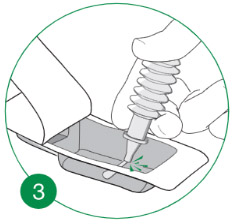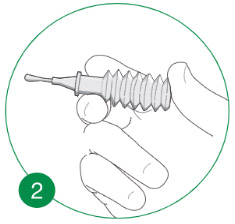Why Is It Important To Use Lubrication When Catheterizing?
- The instillation of lubricant opens the urethra for the catheter, making the catheter less likely to catch in the folds of the lining of the urethra or in the narrowed portion of the urethra such as near the prostate in males to reduce the risk of pain and injury.
What Are The Benefits Of Instilling Lubricant Directly Into The Urethra?
- The entire urethra is more evenly coated with lubricant to open and expand the urethra.
- The instillation of lubricant opens the urethra for the catheter. This makes it less likely to catch in the folds of the lining of the urethra or in a narrowed portion of the urethra such as near the prostate in males to reduce the risk of pain and injury.
- A more even coating of lubricant on the urethral lining can reduce the risk of damage to the urethra by friction or stretching caused by contact with the catheter. This cannot be done by coating the tip of a catheter since much of the lubricant is often pushed back and off the catheter as the catheter is pushed into the closed urethra.
What Are the Benefits Of Having An Anesthetic In The Lubricating Gel?
- Individuals often experience pain or discomfort during catheterization. This is common during the early phases of learning to perform intermittent self-catheterization. It is important to have catheter lubrication along the entire length of the catheter to minimize the risk of pain and injury. In men, the correct positioning of the urethra can decrease pain and discomfort. Pain and discomfort usually decrease over time with increased experience.1
- The addition of an anesthetic to a urethral lubricating gel helps protect against pain caused by the stretching of the urethra and friction of the catheter on the lining of the urethra.2,3
Is Cathejell Covered By Insurance Plans?
- Cathejell is covered by some drug insurance plans which cover non-prescription products. Sometimes it will be covered by other medical plans if your doctor does write a prescription for it. Coverage varies by individual plans, so if you provide your pharmacist with your drug plan information, they can check their database to see if it is covered.
There Is Still Some Gel In The Folds Of The Syringe, How Do I Get It Out?
- After you have fully compressed the syringe and the gel has stopped flowing out, you will find a small amount of gel is still in the folds of the syringe. There is no need to try and get out the small amount of gel still left in the syringe folds. The amount you have gotten out by compressing the syringe supplies enough gel to open the urethra and thoroughly lubricate it.
 I Am Having Trouble Removing The Tip Seal At The End Of The Cathejell Syringe To Open It. Any Suggestions?
I Am Having Trouble Removing The Tip Seal At The End Of The Cathejell Syringe To Open It. Any Suggestions?
- With a little practice, removing the tip seal with one hand becomes very easy.
- The tip seal is designed to be removed with one hand by using a firm downward stroke on any sterile surface such as the bottom of the sterile blister pack that Cathejell came in. Review the instructions for use in the patient leaflet provided with your Cathejell and on this website. You can also see this shown in a video on this website that shows how to open it.
- Do not try and bend the tip seal back and forth between your fingers as this method may not exert enough force to snap off the tip and it may just remain in place.
- If this happens it may take considerable force with two hands to twist it off or it may have to be disposed of.
What Is In Cathejell?
- When fully compressed, each 13.3 g syringe of Cathejell expresses approximately 10 g (9.4 mL) 200 mg of lidocaine hydrochloride which contains lidocaine hydrochloride, 20 mg / g, (2% w/w). .
- It also has the following non-medicinal ingredients; Glycerol, hydrochloric acid, hydroxyethylcellulose, sodium hydroxide, and water for injection.
Does Cathejell Have Latex?
- No; there is no latex in Cathejell.
 Sometimes I Get Suction At The Tip Of The Cathejell Syringe, How Do You Stop It From Happening?
Sometimes I Get Suction At The Tip Of The Cathejell Syringe, How Do You Stop It From Happening?
- Preventing suction is as simple as remembering to keep the syringe compressed while removing the syringe from your urethra to avoid any suction. Once you are no longer in contact with the urethra you can release the pressure on the syringe and dispose of it.
- Review the instructions for use in the patient leaflet provided with your Cathejell and on this website. You can also see this in a video on this website that shows how to use it.
References
- Clean Intermittent Urethral Catheterization in Adults, Canadian Best Practice Recommendations for Nurses, April 2020, Urology Nurses of Canada, https://unc.org/wp-content/uploads/2020/05/Clean-Intermittent-Urethral-Catheterization-Adults-for-Nurses-BPR-May2020-1.pdf
- Tzortzis et al, Intraurethral Lubricants: A Critical Literature Review and Recommendations, Journal of Endurology, Vol 23, Number 5, May 2009 p 821-826
- Aygin D, Usta E, The effect of lubricants used in indwelling bladder catheterization through urethra on procedure-related pain: a literature review, Int J Clin Exp Med 2017;10(2):1995-2005, www.ijcem.com


 2476 Argentia Road, Suite 402
2476 Argentia Road, Suite 402 1.888.439.0013
1.888.439.0013 905.206.1413
905.206.1413 cathejell@biosyent.com
cathejell@biosyent.com